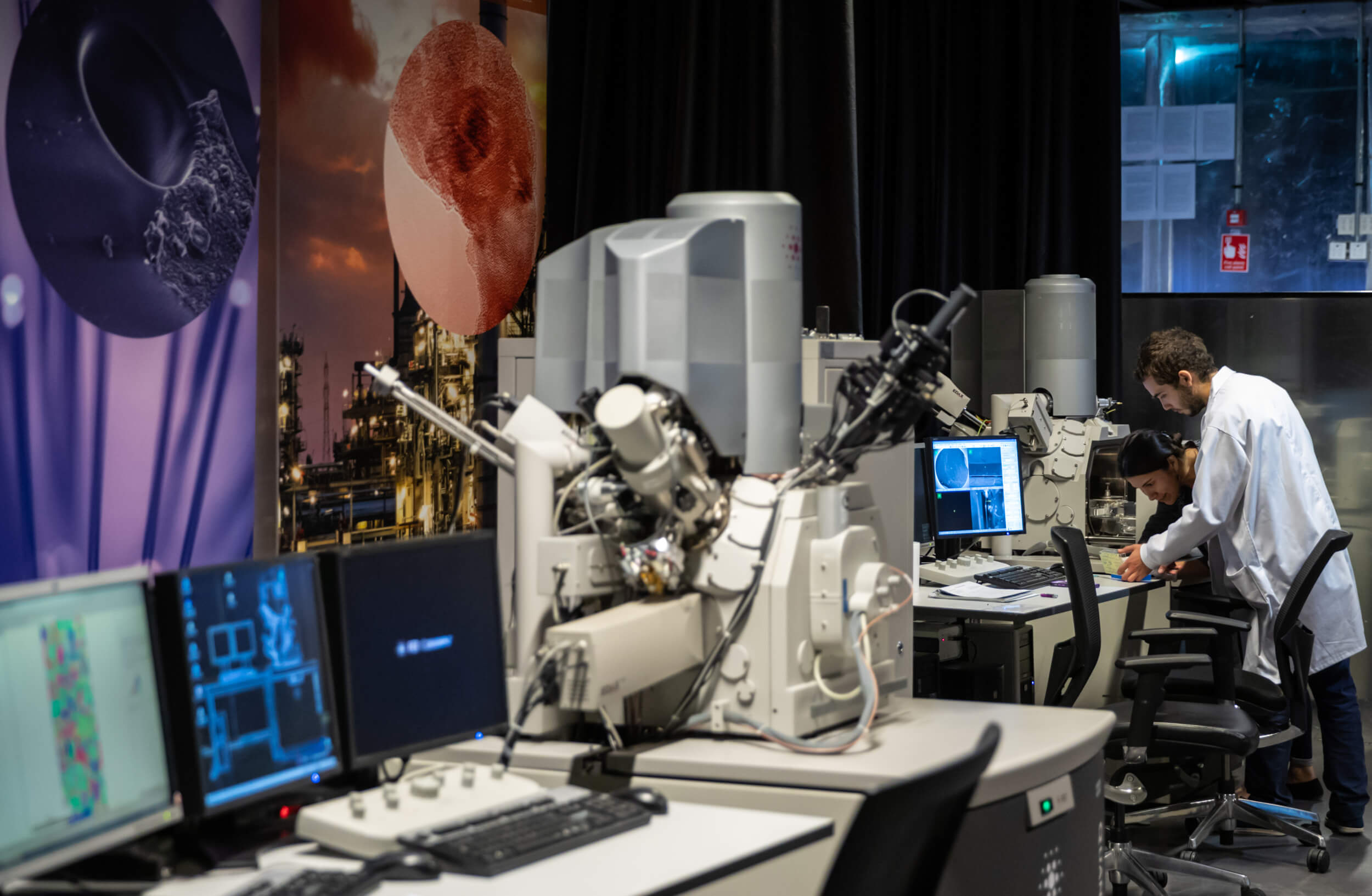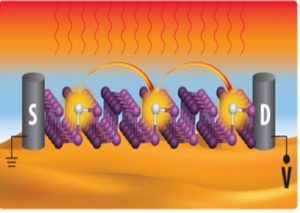
KU researchers presented eight conference papers at the Materials Research Society’s (MRS) flagship conference, the 2019 MRS Fall Meeting & Exhibition, which took place from 1 – 6 December 2019 in Boston, Massachusetts, USA.
The eight papers presented by KU faculty, researchers, and students demonstrated the university’s robust materials science research activities.
Two KU faculty members are the principal investigators for the papers presented at the conference – Dr. Matteo Chiesa, Professor of Mechanical Engineering and head of the Laboratory for Energy and Nano Science (LENS), and Dr. Rashid Abu Al-Rub, Professor and Acting Chair of Aerospace Engineering, Director of Advanced Digital and Additive Manufacturing Group (ADAM) and Professor of Mechanical Engineering.
Dr. Chiesa presented two papers. In the first paper, titled “GeS Field Effect Transistor for High Temperature Applications,” Dr. Chiesa describes how his team investigated the effects that intrinsic crystal defects in an ultrathin, 2D germanium sulfide (GeS) material have on the material’s electrical properties at different temperatures. More specifically, he studied how the crystal defects effect the germanium sulfide’s behavior as a field effect transistor (FET) that amplify and switch electronic signals.
 Boulos Alfakes, PhD student under the supervision of Dr. Chiesa, also presented two papers. His first paper was titled “Effect of Hf Doping on ZnO Photo-Anode.” In this project, Alfakes and his team developed an enhanced zinc oxide-based anode for use in a photoelectrochemical (PEC) cell – a device that splits water and produces hydrogen. The researchers doped the zinc oxide with the chemical element hafnium, using an atomic layer deposition (ALD) approach. They observed a 250% increase in the photocurrent, or the electric current induced from light, travelling in the anode.In his second paper, titled “Spectroscopy Studies on Multi-Layer InSe with Visible Range Band Gap,” Dr. Chiesa revealed important properties of the 2D material indium selenide (InSe). His team used Raman spectroscopy, a technique involving light scattering to understand material properties, to determine the electronic band structure and lattice vibrations of indium selenide and indium selenide coated with graphene. Both papers’ co-authors include Dr. Srinivasa Tamalampudi, Dr. Raman Sankar, Dr. Ibraheem Almansouri, and Dr. Jin-You Lu.
Boulos Alfakes, PhD student under the supervision of Dr. Chiesa, also presented two papers. His first paper was titled “Effect of Hf Doping on ZnO Photo-Anode.” In this project, Alfakes and his team developed an enhanced zinc oxide-based anode for use in a photoelectrochemical (PEC) cell – a device that splits water and produces hydrogen. The researchers doped the zinc oxide with the chemical element hafnium, using an atomic layer deposition (ALD) approach. They observed a 250% increase in the photocurrent, or the electric current induced from light, travelling in the anode.In his second paper, titled “Spectroscopy Studies on Multi-Layer InSe with Visible Range Band Gap,” Dr. Chiesa revealed important properties of the 2D material indium selenide (InSe). His team used Raman spectroscopy, a technique involving light scattering to understand material properties, to determine the electronic band structure and lattice vibrations of indium selenide and indium selenide coated with graphene. Both papers’ co-authors include Dr. Srinivasa Tamalampudi, Dr. Raman Sankar, Dr. Ibraheem Almansouri, and Dr. Jin-You Lu.
Alfakes’ second paper was titled “Hf Doped ZnO Engineering for Various Solar Cells Architectures.” In this study, Alfakes and his team took precise measurements using scanning and transmission electron microscopy, x-ray diffraction, Kelvin probe force microscopy, and other characterization techniques to provide conclusive evidence that hafnium doped zinc oxide produces a tunable band gap and work function, as well as decreases electrical resistivity, making it an ideal material for solar cell applications.
Dr. ChunYu Lu, Postdoctoral Fellow working under Dr. Chiesa, presented a paper titled “Density Functional Theory Simulation on Material Science—Bridging the Gap Between Theory and Experiment.” In this research, Dr. Lu and his team performed Density Functional Theory (DFT) – a computational modeling method to investigate electronic structures – on 2D materials, including indium selenide, graphene, and doped zinc oxide, to characterize the materials and design ideal material properties for different applications.
Dr. Nitul Rajput, Postdoctoral Fellow working under Dr. Chiesa, presented his research titled “EELS study of Vertically grown Graphene sheets on Ge.” The poster describes how his team used transmission electron microscopes (TEM) – a type of microscope that uses a beam of electrons instead of light to see through a material – and electron energy loss spectroscopy (EELS) – a technique to measure the change in kinetic energy of electrons after they interact with a specimen – to study and investigate the carbon bonds within a vertically grown carbon material on germanium. This study will bring new insight into the growth mechanism of graphene sheets on semiconductor materials.
Juveiriah M. Ashraf, an MSc student in Materials Science and Engineering supervised by Prof. Rashid Abu Al-Rub and Prof. Kin Liao, presented two papers. The first was titled “Three-Dimensional Architected Graphene Lattices from Additively-Manufactured Polymer Templates.” Juveiriah described how her team developed a simple, scalable, and architecturally versatile additive manufacturing approach to creating 3D graphene structures based on triply periodic minimal surfaces (TPMS), which are cellular lattices that have perfectly curved surfaces with no self-intersecting or enfolded surfaces. Being able to translate graphene’s unique 2D properties – particularly, its exceptional strength and conductivity – into a 3D form will extend the potential application of graphene into numerous fields.
Juveiriah’s second papers was titled “Effective Thermal/Electrical Conductivities of Three-Dimensional Cellular Architectures based on Triply Periodic Minimal Surfaces.” She compared the electrical and thermal conductivity of three different types of TPMS structures – Gyroid, IWP and Diamond shapes using computational modelling. Her findings indicate that the sheet network version of each structure demonstrated higher conductivities compared to the solid networks, and that the IWP sheet network demonstrated the highest conductivity overall. The research was then used to compare the thermal and electrical conductivities of graphene-based TPMS structures that were fabricated experimentally.
The Fall Meeting & Exhibit is the world’s foremost international scientific gathering for materials research. The meeting provided an opportunity to spotlight some of the innovative materials science research and advanced capabilities being developed at KU.
Erica Solomon
Senior Editor
10 December 2019






